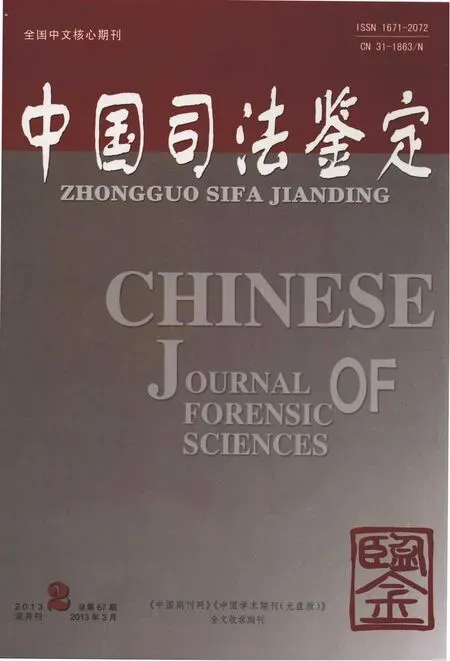分子印迹技术及其在司法鉴定领域的应用
王松才,李攻科
(1.中山大学 化学与化学工程学院,广东 广州510275;2.广州市刑事科学技术研究所,广东 广州510030)
分子印迹技术及其在司法鉴定领域的应用
王松才1,2,李攻科1
(1.中山大学 化学与化学工程学院,广东 广州510275;2.广州市刑事科学技术研究所,广东 广州510030)
分子印迹技术(MIT)是制备对特定目标分子具有分子识别功能聚合物(MIPs)的一门技术,由于MIPs具有的选择性,被广泛应用于各领域。对MIT和MIPs进行了介绍,并对其在司法鉴定领域的应用进行了综述。
分子印迹技术;分子印迹聚合物;司法鉴定
1 分子印迹技术(MIT)简介
分子印迹技术(MIT)是指制备对特定目标分子具有选择性识别功能的聚合物的技术。其制备过程可以简单描述为:在适当的溶剂体系中使模板分子与功能单体通过可逆的共价作用或非共价作用形成模板-单体复合物;然后加入交联剂并在合适的引发方式作用下,在模板-单体复合物周围发生聚合反应,生成高聚物;最后洗脱除去模板分子,从而在高聚物中形成与原模板分子在空间结构上相匹配,可以与原模板分子进行可逆专一结合的三维空穴。可见,采用不同的模板分子制备的分子印迹聚合物(MIPs)应具有不同的三维空穴结构和性质,会优先与原模板分子结合,即MIPs对原模板分子具有了选择性结合识别能力。正是由于特定的空穴结构对模板分子的“记忆功能”,使MIPs对模板分子的亲和力增强,表现出类似天然生物大分子(如酶、抗体等)的分子识别能力。MIPs依靠其自身的三维空穴的形状、大小和化学功能团的分布对模板分子进行识别,理论上具有专一选择性;相对于天然抗体,MIPs具有易于制备,可以实现快速制备的特点,而且热稳定性、化学稳定性良好,价格便宜。当然,MIPs也存在一些不足:包括产物结合位点不均匀,使用过程可能存在模板分子“渗漏”现象,其三维空穴可能因“坍塌”而改变;传统方法需要先制得块状物,然后把块状物进行粉碎、研磨、过筛,再选取合适尺寸微粒供使用,该过程不但费时,费力,产率低下,而且得到的颗粒也不规则,不均匀。因此,分子印迹聚合物的制备一直没有得到人们的重视。1983年,Vlatkis等[1]在《Nature》杂志上发表了关于茶碱分子印迹聚合物的研究报告后,分子印迹技术得到了广泛关注,并飞速发展。近年来,随着高分子化学与物理,生物化学和分析化学等学科的发展,分子印迹技术在印迹机理、印迹聚合物的制备、印迹技术的应用及其热力学、动力学等方面的理论研究取得了长足的进展。如今,分子印迹技术已经在各领域,包括色谱分离[2-4],仿生化学传感器[5-7],催化技术[8],固相萃取技术[9-12],固相微萃取技术[13-15],表面修饰磁搅拌子技术[16-18],药物缓释与疾病诊断技术[19-20]等,得到广泛的研究和应用。其在司法鉴定领域的应用也得到了法庭科学家的广泛研究。
2 分子印迹技术在司法鉴定中的应用研究
2.1 分子印迹技术在司法鉴定炸药残留物检验中的应用研究
爆炸案件作为社会危害性最大的刑事案件之一,长期受到全球的高度关注,爆炸案件更是各国反恐怖袭击工作的重点。通常,炸药爆炸后,只有痕量的炸药原体样品残留在爆炸现场,并且受到现场复杂基质的严重干扰。因此,如何准确、快速地从现场复杂基质中分离、提取、检测炸药残留物,确定爆炸的性质,提供有价值的侦察方向,仍然是法庭科学化学家的一项挑战。Sonia Lordel等[21]研究发现,以 2,4-DNT 为模板分子,PTMS为单体,TEOS为交联剂,碱性水溶液为介质,合成硝基芳香族炸药的分子印迹聚合物修饰在硅胶微球上制备成 SPE萃取柱,对 2,4-DNT,2,4,6-TNT和2,6-DNT均有良好的选择性。为了进一步考察其实用性,作者通过用其处理被机油污染的样品,并将其与Oasis HLB商品柱进行比较,证明其性能优于Oasis HLB商品柱。Gudrun Bunte等[22]采用紫外引发悬浮聚合方式,在石英晶体微量天平表面修饰TNT或DNT分子印迹聚合物,用于TNT等炸药的现场快速检测。可以预见,MIPs修饰的各种传感器技术在炸药的快速检测中将发挥越来越重要的作用。Dongxia Nie等[23]在纳米金微粒修饰的玻璃碳电极表面通过自组装方式再修饰上TNT的分子印迹聚合物,制备了TNT的电化学传感器,对 TNT检测的线性范围从 4.0×10-8到 3.2×10-6mol/L,检测限为1.3×10-8mol/L (S/N=3),该分子印迹检测器被用于环境水样中的微量TNT检测并证实是一种快速灵敏的检测方法。
2.2 分子印迹技术在司法鉴定毒品检验中的应用研究
毒品犯罪与吸毒现象给国家、社会和个人造成了巨大的损害,这不仅包括吸毒者本身的损害,也包括了吸毒者由于吸食毒品而丧失了劳动能力对社会所造成的损失,社会为救治吸毒者和因吸毒而引发的其它传染疾病等付出的巨额医疗费用,以及吸毒者因毒资需要而衍生出的各种侵财犯罪、性犯罪等。为了维护社会的稳定,净化社会环境,各国政府均付出了大量的人力物力,但至今仍未取得明显成效。对毒品吸食者体内毒品的准确、快速检测是法庭科学化学家另一项重要的日常任务。在司法鉴定领域,常见的生物检材包括血液、尿液、唾液、毛发以及脏器等复杂样品;关于检材的前处理方法常用的有液液萃取、固相萃取和固相微萃取等。分子印迹技术在这方面的应用研究同样得到了人们的重视。Yeh等[24]用含有吗啡模板分子的0.1M LiClO4溶液,通过电聚合反应把PEDOT聚合到ITO电极上,制备了一种吗啡分子印迹聚合物修饰的电极检测器用于吗啡的检测,其检测的线性范围在0.1~1mM。Hsu等[25]以MAA为功能单体,EDMA为交联剂,通过热引发自由基共聚合反应制备了一种吗啡分子印迹聚合物,结合Fe3+和[Fe(CN)6]3-体系,采用比色法检测吗啡,其检测限可以达到28.5ng/ml。Piletska等[26]设计和制备了基于分子印迹聚合物的四种毒品的复合传感器,并提出应用该技术制备便携式毒品快速筛选检测设备的设想。Hao等[27]以MAA为功能单体,EDMA为交联剂,AIBN为引发剂,制备了一种基于表面等离子体共振光谱(SPR)的吗啡分子印迹传感器,其对吗啡检测的线性范围在1ppb~1ppm间,最低检测限达到10-10mol/L。Djavanshir Djozan等[28]以海洛因为模板分子,MAA为功能单体,EDMA为交联剂,AIBN为引发剂,制备了一种海洛因分子印迹固相微萃取整体柱(MISPME),结合GC或GC/MS,用于水溶液中海洛因及其类似物6-单乙酰可待因,6-单乙酰吗啡的萃取检测,其检测限分别为300,47和1ng/mL。所合成的固相微萃取纤维在300℃条件下稳定性良好。 Valérie Thibert等[29]以可卡因为模板分子,MAA为功能单体,EDMA为交联剂,通过光引发合成可卡因的分子印迹聚合物制备SPE柱,用于富集提取头发中的可卡因和其酸性代谢产物苯甲酰爱康宁,然后用LC/MS检测,两者的最低检测限均达到0.07ng/mg。常靖等[30]研究采用Sigma公司出品的分子印迹固相萃取商品柱(SupelMIP SPEAmphetamine,25mg/3mL)提取血液中的苯丙胺类毒品,结合GC/NPD或GC/MS法检测,结果苯丙胺类毒品的回收率均在90%以上。
2.3 分子印迹技术在司法鉴定药毒物检测中的应用研究
在司法鉴定中另一项具有挑战性的工作是复杂基质(生物样品)中药毒物(包括安眠药、农药、鼠药等)的筛选检测,一方面司法鉴定科学家希望建立具有普适性的提取方法以适应无目标情况下的系统筛选需求;另一方面更需要有对特定目标化合物选择性强的具有针对性的前处理手段,以保证在目标化合物明确的条件下高灵敏度、快速的检测需求。分子印迹技术可以很好的满足第二方面的需求。Marinah M.Ariffin等[31]研究制备了安定的分子印迹固相萃取柱,结合LC/MS法用于头发中安定及其代谢产物和其它苯二氮卓类药物的提取检测,所合成的MISPE材料对安定的吸附能力达到每毫克MIPs可以吸附110ng安定,空白添加试验对头发中安定的提取回收率为93%(RSD=1.5%),方法的最低检测限达到0.09ng/mg,定量分析下限为0.14 ng/mg。该方法经与ELISA数据比较,结果非常吻合。在此基础上,Robert A.Anderson等[32]系统研究比较了所合成的安定MISPE与传统SPE方法对9种苯二氮类药物的提取效果,并对10例实际案例头发中苯二氮类药物进行分离提取检测,结果表明MISPE在选择性、回收率、方法检测限等方面总体上优于传统的SPE方法。Guoyou Jin等[33]采用溶胶-凝胶法合成了三唑仑分子印迹硅胶微球并制备了MISPE柱,结合HPLC用于尿中三唑仑及其主要代谢产物α-羟基三唑仑的富集提取,其方法检测限分别为30ng/mL和33ng/mL。A.Beltran等[34]以巴比妥为模板分子,BAP为功能单体,DVB-80为交联剂,通过沉淀聚合法合成巴比妥的MIPs微球,制备MISPE柱,并采用一种串联的处理方式萃取尿样中的巴比妥类药物,可以有效地排除杂质的干扰,获得良好的分析效果。
强极性水溶性毒物的提取净化一直是毒物检验所要面临的前处理难题之一,例如,有机磷农药作为乙酰胆碱酯酶的抑制剂,在农业生产中广泛使用,也是司法鉴定中经常遇到有机毒物,其中的部分农药即具有强极性、强水溶性的特点,Xiaolan Zhu等[35]合成了以久效磷为模板分子的分子印迹聚合物,制备了MISPE柱用于环境中水样和泥土样品中的久效磷、速灭磷、磷胺和氧乐果分离检测,具有很好的选择性,水中样品回收率在77.5%~99.1%,泥土中样品回收率在79.3%~93.5%之间,优于液液提取和传统的SPE方法。Georgios Theodoridis等[36]以天仙子胺为替代模板分子,MAA为功能单体,EDMA为交联剂,合成了东莨菪碱的MIPs,制备MISPE柱用于人和牛尿、血清中东莨菪碱的提取分离,回收率达到79%。
3 展望
目前,分子印迹聚合物的分子识别能力在实际应用中还无法与生物大分子(如酶等)相比,但是随着分子印迹技术在印迹机理、印迹聚合物的制备与表征、印迹聚合物在各领域的应用积累以及在热力学、动力学等方面的理论研究的深入,分子印迹技术和印迹聚合物将进一步与各种新兴技术有机结合,并且进一步走向成熟,被广发应用于包括司法鉴定在内的各领域,在现场快速检测技术方面更是有着广泛的应用前景,可以预见,分子印迹技术将成为司法鉴定领域法庭科学家手中强有力的检测新技术。
[1]G.Vlatkis, L.I.Andersson, R.Muller, et al.Drug Assay Using Antibody Mimics Made by Molecular Imprinting[J].Nature(London), 1983,(361):645.
[2]Xiaodong Huang, HanfaZou, Xiaoming Chen, et al.Molecularly imprinted monolithic stationary phase for liquid chromatographic separation of enantiomers and diastereomers[J].Journal of Chromatography A, 2003,(984):273-282.
[3]欧俊杰,董靖,吴明火,等.分子印迹整体柱在高效液相色谱和电色谱手性分离中的应用[J].色谱, 2007,25(2):129-134.
[4]Jun Haginaka,Monodispersed.molecularly imprinted polymers as affinity-base chromatography media[J].Journal of Chromatography B, 2008,(866):3-13.
[5]KarstenHaupt,KlausMosbach.Molecularly Imprinted Polymers and Their Use in Biomimetic Sensors[J].Chem.Rev,2000,(100):2495-2504.
[6]RongningLiang, RuimingZhang, Wei Qin.Potentiometric sensor based on molecularly imprinted polymer for determination of melamine in milk[J].Sensors and Actuators B,2009,(141):544-550.
[7]Liang Feng, Yongjun Liu, Yiyong Tan, et al.Biosensor for the determination of sorbitol based on molecularly imprinted electrosynthesized polymers[J].Biosensors and Bioelectronics,2004,(19):1513-1519.
[8]Goretti Diaz-Diaz, YolandaDineiro, M.Isabel Menendez, et al.Molecularly imprinted catalytic polymers with biomimetic chloroperoxidase activity[J].Polymer, 2011,(5):2468-2473.
[9]Z.Sun, W.Schussler, M.Sengl, et al.Selective trace analysis of diclofenacin surface and wastewater samples using solidphase extraction with a new molecularly imprinted polymer[J].ANALYTICA CHIMICA ACTA, 2008,(620):73-81.
[10]E.Caro, R.M.Marce, F.Borrull, et al.Application of molecularly imprinted polymers to solid-phase extraction of compounds from environmental and biological samples[J].Trends in Analytical Chemistry,2006,25(2):143.
[11]Chiyang He, Yuanyuan Long, Junlan Pan, et al.Application of molecularly imprinted polymers to solid-phase extraction of analytes from real samples[J].J.Biochem.Biophys.Methods, 2007,(70):133-150.
[12]GuifenZhu, JingFan, YanbuGao, et al.Synthesis of surface molecularly imprinted polymer and the selective solid phase extraction of imidazole from tis structural analogs[J].Talanta,2011,(84):1124-1132.
[13]Xiaogang Hu, Jialiang Pan, Yuling Hu, et al.Preparation and evaluation of solid-phase microextractionfiber based on molecularly imprinted polymers for trace analysis of tetracyclines in complicated samples[J].Journal of Chromatography A, 2008,(1188):97-107.
[14]FengTan, HongxiaZhao, Xiaona Li, et al.Preparation and evaluation of molecularly imprinted solid-phase microextraction fibers for selective extraction of bisphenol A in complex samples[J].Journal of Chromatography A, 2009,(1216):5647-5654.
[15]DjavanshirDjozan,BahramEbrahimi.Preparation of new solid phase micro extraction fiber on the basis of atrazine-molecular imprinted polymer:Application for GCand GC/MS screen-ing of triazine herbicides in water,tice and onion[J].ANALYTICA CHIMICA ACTA, 2008,(616):152-159.
[16]Zhigang Xu, Yufei Hu, Yuling Hu, et al.Investigation of ractopamine molecularly imprinted stir bar sorptive extraction and its application for trace analysis of β2-agonists in complex samples[J].Journal of Chromatography A, 2010,(1217):3612-3618.
[17]Yuling Hu, Jiawei Li, Yufei Hu, et al.Development of selective and chemically stable coating for stir bar sorptive extraction by molecularly imprinted technique[J].Talanta, 2010,(82):464-470.
[18]Lieqing Yang, Xiaomin Zhao, Jie Zhou.Selective enrichment and determination of nicosulfuron in water and soil by a stir bar based on molecularly imprinted polymer coatings[J].AnalyticaChimicaActa, 2010,(670):72-77.
[19]C.J.Allender, C.Richardson, B.Woodhouse, et al.Pharmaceuticalapplications for molecularly imprinted polymers[J].International Journal of Pharmaceutics, 2000,(195):39-43.
[20]Sergey A.Piletsky, NicholasW.Turner, Peter Laitenberger.Molecularly imprinted polymers in clinical diagnostics-Future potential and existing problems[J].Medical Engineering&Physics, 2006,(28):971-977.
[21]Sonia Lordel, Florence Chapuis-Hugon, Véronique Eudes,et al.Development of imprinted materials for the selective extraction of nitroaromatic explosives[J].Journal of Chromatography A, 2010,(1217):6674-6680.
[22]Gudrun Bunte, Jürgen Hürttlen, Heike Pontius, et al.Gas phase detection of explosives such as 2,4,6-trinitrotoluene by molecularly imprinted polymers[J].Analytica Chimica Acta, 2007,(591):49-56.
[23]Dongxia Nie, Dawei Jiang, Dan Zhang, et al.Two-dimensional molecular imprinting approach for the electrochemical detection of trinitrotoluene[J].Sensors and Actuators B, 2011,(156):43-49.
[24]Wei-Ming Yeh,Kuo-Chuan Ho.Amperometric morphine sensing using a molecularly imprinted polymer-modified electrode[J].Analytica Chimica Acta, 2005,(542):76-82.
[25]Huan-Cheng Hsu, Lin-Chi Chen, Kuo-Chuan Ho.Colorimetric detection of morphine in a molecularly imprinted polymer using an aqueous mixture of Fe3+and[Fe(CN)6]3[J].Analytica Chimica Acta, 2004,(504):141-147.
[26]Elena V.Piletska, Maria Romero-Guerra, Iva Chianella, et al.Towards the development of multisensor for drugs of abuse based on molecular imprinted polymers[J].Analytica Chimica Acta, 2005,(542):111-117.
[27]Hong Xia Hao, Hong Zhou, Jing Chang, et al.Molecularly imprinted polymers for highly sensitive detection of morphine using surface Plasmon resonance spectroscopy[J].Chinese Chemical Letters, 2011,(22):477-480.
[28]Djavanshir Djozan,Tahmineh Baheri.Preparation and evaluation of solid-phase microextraction fibers based on monolithic molecularly imprinted polymers for selective extraction of diacetylmorphine and analogous compounds[J].Journal of Chromatography A, 2007,(1166):16-23.
[29]Valérie Thibert, Patrice Legeay, Florence Chapuis-Hugon,et al.Synthesis and characterization of molecularly imprinted polymers for the selective extraction of cocaine and its metabolite benzoylecgonine from hair extract before LC-MS analysis[J].Talanta, 2012,(88):412-419.
[30]常靖,朱军,邸玉敏,等.分子印迹固相萃取法在血中苯丙胺类毒品分析中的应用[J].中国法医学杂志,2011,26(1):22-25.
[31]Marinah M.Ariffin, Eleanor I.Miller, Peter A.G.Cormack,et al.Molecularly Imprinted Solid-Phase Extraction of Diazepam and Its Metabolites from Hair Samples[J].Anal.Chem,2007,(79):256-262.
[32]Robert A.Anderson,Marinah M.Ariffin,Peter A.G.Cormack,et al.Comparison of molecularly imprinted solid-phase extraction (MISPE)with classical solid-phase extraction (SPE)for the detection of benzodiazepines in post-mortem hair samples[J].Forensic Science International, 2008,(174):40-46.
[33]Guoyou Jin, Baofei Zhang, Youwen Tang, et al.Imprinted functionalized silica sol-gel for solid-phase extraction of triazolamin[J].Talanta, 2011,(84):644-650.
[34]A.Beltran, F.Borrull, P.A.G.Cormack, et al.Molecularly imprinted polymer with high-fidelity binding sites for the selective extraction of barbiturates from human urine[J].Journal of Chromatography A, 2011,(1218):4612-4618.
[35]Xiaolan Zhu, Jun Yang, Qingde Su, et al.Selective solidphase extraction using molecularly imprinted polymer for the analysis of polar organophosphorus pesticides in water and soil samples[J].Journal of Chromatography A, 2005,(1092):161-169.
[36]Georgios Theodoridis, Andreas Kantifes, Panagiotis Manesiotis,et al.Preparation of a molecularly imprinted polymer for the solid-phase extraction of scopolamine with hyoscyamine as a dummy template molecule[J].Journal of Chromatography A, 2003,(987):103-109.
Molecular Imprinting Technology and its Application in Forensic Science
WANG Song-cai1,2,LI Gong-ke1
(1.School of Chemistry and Chemical Engineering,Sun Yat-sen University,Guangzhou 510275,China;2,Institute of Forensic Science,Guangzhou Public Security Bureau,Guangzhou 510030,China)
Molecular imprinting technology (MIT) is the technology preparing the molecular imprinting polymers (MIPs) that have the molecular recognition function for particular target compound.MIPs have been applied in different fields for their selectivity.This paper presents the MIT and MIPs and reviews its application in forensic science.
MIT; MIPs; forensic science
DF795.1
A
10.3969/j.issn.1671-2072.2013.02.013
1671-2072-(2013)02-0055-04
2012-09-06
王松才(1971—),男,高级工程师,硕士研究生,主要从事毒物、毒品和微量物证分析研究。E-mail:songcaiwang@126.com。
李攻科(1963—),女,博士,教授,博士研究生导师,主要从事分析化学的教学与研究工作。E-mail:cesgkl@sysu.edu.cn。
卓先义)
鉴定实践Forensic Practice

